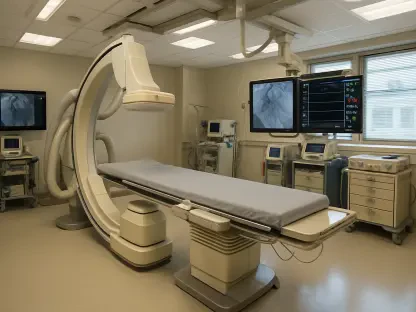Imagine a scenario where a rural patient, miles from the nearest hospital, can consult with a specialist without stepping out the door, or where a senior with mobility issues receives mental health support through a simple phone call, embodying the promise of telehealth as a lifeline for millions of Americans now facing a critical turning point. Introduced on September 2 as H.R. 5081 by Representatives Earl “Buddy” Carter (R-GA) and Debbie Dingell (D-MI), this significant piece of legislation aims to secure these virtual healthcare services by extending vital flexibilities set to expire at the end of September. With bipartisan backing and a companion bill anticipated in the Senate, this act emerges as a beacon of hope to avert a disruptive “telehealth cliff” that could sever access for countless individuals relying on remote care. It’s not merely a temporary fix but a bold step toward embedding digital solutions into the healthcare landscape, ensuring that geography or circumstance no longer dictates access to medical support.
This legislative effort arrives at a pivotal moment when the expiration of Medicare’s temporary waivers threatens to roll back years of progress in remote healthcare delivery. By pushing for a two-year extension of these provisions until September 30, 2027, the bill offers breathing room for stakeholders to develop a sustainable framework. Beyond preservation, it introduces measures to address equity, security, and specific care needs, reflecting a nuanced understanding of telehealth’s role in modern medicine. The bipartisan support underscores a rare consensus on the importance of maintaining virtual care options for vulnerable populations, including seniors, rural residents, and those with disabilities. As the deadline looms, the urgency to act intensifies, with the potential to shape how healthcare is delivered for years to come. This comprehensive approach seeks to balance immediate needs with long-term goals, ensuring that the benefits of telehealth reach every corner of society while safeguarding against misuse.
Key Features of the Telehealth Modernization Act
Extending Telehealth Flexibilities
A cornerstone of this legislation is the extension of pandemic-era telehealth waivers for an additional two years, through September 30, 2027, preventing a sudden lapse in access to virtual care. This provision eliminates geographic restrictions, allowing patients in urban settings and their own homes to receive services, rather than being limited to rural designated sites. It also expands the range of practitioners eligible to provide telehealth under Medicare, ensuring a wider pool of professionals can meet growing demand. Notably, audio-only services remain an option, a critical feature for those without access to video technology or reliable broadband. Federally Qualified Health Centers (FQHCs) and Rural Health Clinics (RHCs) continue as distant-site providers, reinforcing community-based care delivery. Additionally, the delay of in-person requirements for behavioral health services reduces barriers to mental health support, addressing a pressing national need with practical solutions.
Beyond these broad extensions, the bill tackles specific procedural flexibilities to sustain telehealth’s reach across diverse healthcare scenarios. For instance, it permits telehealth for face-to-face encounters prior to hospice care recertification, though with certain limitations starting January 1, 2026, such as restrictions in areas under hospice moratoriums or for providers under enhanced oversight. This nuanced approach aims to balance accessibility with accountability, ensuring that telehealth remains a viable option without compromising care standards. The inclusion of such detailed provisions reflects an intent to adapt telehealth to varied medical contexts, from routine consultations to end-of-life care. By maintaining these flexibilities, the legislation provides a safety net for patients and clinicians alike, allowing time to evaluate and refine telehealth’s integration into mainstream healthcare systems while preventing abrupt disruptions that could harm vulnerable groups.
Enhancing In-Home and Preventive Care
One of the standout features of this act is the extension of the Acute Hospital Care at Home program through 2030, enabling patients to receive hospital-level treatment in their homes via telehealth and remote monitoring tools. This initiative not only enhances patient comfort but also potentially reduces healthcare costs by minimizing hospital stays. The bill mandates a comprehensive study by the Department of Health and Human Services (HHS) by September 30, 2028, to assess outcomes, costs, quality of care, and staffing models. These findings will guide Congress in determining whether to make the program a permanent fixture in healthcare delivery. Such forward-thinking measures underscore a commitment to leveraging technology for acute care, ensuring that even complex medical needs can be addressed outside traditional hospital settings, particularly for those with mobility or transportation challenges.
Another significant provision targets preventive care through the Medicare Diabetes Prevention Program (DPP), extending virtual coverage from 2026 through 2030. This includes support for live audio-video and self-paced digital models, while removing state-line restrictions for providers to operate nationally and allowing patient re-enrollment. These changes aim to broaden access to critical interventions that help manage and prevent diabetes, a condition affecting millions of Americans. Additionally, the bill supports in-home cardiac and pulmonary rehabilitation via real-time audio-video telehealth through January 1, 2027, with supervising clinicians able to oversee sessions virtually. This flexibility reduces the need for physical presence, making rehabilitation more accessible for patients recovering at home. Together, these provisions highlight a strategic focus on using telehealth to address both chronic disease prevention and recovery, tailoring solutions to meet specific health challenges.
Impact on Healthcare Delivery
Benefits for Patients and Clinicians
For patients, particularly those in rural or underserved regions, this legislation ensures continued access to telehealth services that have become indispensable for managing both routine and specialized care. The ability to connect with providers from home, regardless of location, breaks down long-standing barriers posed by distance or mobility limitations. Audio-only options cater to individuals lacking advanced technology, while language accessibility measures, aligned with guidance for patients with limited English proficiency (LEP), promote inclusivity by integrating interpreters and multilingual resources into telehealth platforms. These steps address equity concerns, ensuring that non-English speakers or those with technological constraints are not excluded from virtual care. The result is a healthcare system that prioritizes reach and fairness, empowering patients to seek timely medical attention without the burden of travel or language obstacles.
Clinicians, meanwhile, gain operational stability through the extended telehealth flexibilities, allowing them to serve a broader patient base without the looming threat of policy reversals. The continued designation of FQHCs and RHCs as distant-site providers strengthens community health centers’ ability to deliver remote care to marginalized populations. Furthermore, the delay in mandatory in-person requirements for behavioral health services supports mental health providers in meeting rising demand amid national shortages of specialists. This stability fosters confidence among healthcare professionals to invest in telehealth infrastructure and training, knowing that the framework will remain supportive for at least two more years. However, while these benefits are substantial, they come with the need for adaptation to evolving guidelines, requiring clinicians to stay informed and agile in their practice to fully capitalize on the opportunities presented by the legislation.
Challenges and Oversight
While the benefits of extended telehealth access are clear, the legislation also introduces new administrative challenges that providers must navigate to maintain compliance. For instance, specific reporting requirements tied to hospice care recertification via telehealth, effective from January 1, 2026, demand detailed documentation to avoid penalties or reimbursement delays. These stipulations, while aimed at ensuring quality and accountability, add layers of complexity to already busy clinical workflows. Providers in areas under hospice moratoriums or those facing enhanced scrutiny from the Centers for Medicare & Medicaid Services (CMS) may find these restrictions particularly burdensome. The balance between facilitating access and imposing oversight reflects a cautious approach, but it risks straining smaller practices or those with limited administrative resources, potentially impacting their ability to deliver seamless care.
Additionally, the bill emphasizes fraud prevention, introducing enhanced oversight for durable medical equipment (DME), prosthetics, and orthotics starting January 1, 2028, through mandatory prepayment reviews by CMS. By January 1, 2026, HHS must also identify laboratory tests at high risk for fraud and recommend preventive strategies. These measures aim to protect the integrity of telehealth by curbing misuse, but they place an added burden on providers to ensure claims are meticulously documented and justified. The focus on risk mitigation, while necessary, could inadvertently slow down service delivery or deter some clinicians from fully embracing telehealth due to fear of audits or penalties. Striking a balance between safeguarding against abuse and maintaining ease of use for legitimate providers remains a critical challenge, one that will require careful monitoring as the provisions roll out over the coming years.
Political and Broader Context
Urgency and Legislative Dynamics
The timing of this legislative proposal is nothing short of critical, with Medicare’s telehealth waivers set to expire on September 30, creating a pressing deadline for congressional action. Failure to extend these flexibilities risks reverting to pre-pandemic restrictions, which would eliminate coverage for urban and home-based telehealth outside behavioral health, effectively cutting off millions from essential care. Lawmakers must decide whether to pass this standalone bill or incorporate its provisions into a broader Continuing Resolution expected around the same time. The bipartisan support, evidenced by co-sponsorship across party lines, offers a promising foundation for progress, with advocates like Rep. Carter emphasizing telehealth’s non-political value and Rep. Dingell highlighting its role in equity. Yet, the exact path forward remains uncertain, with potential delays or competing priorities possibly complicating swift resolution.
This urgency is compounded by the broader implications of inaction, which could undermine public trust in healthcare systems already strained by access disparities. The “telehealth cliff” is not just a policy term but a real threat to patients who have come to rely on virtual visits for everything from chronic condition management to emergency consultations. Stakeholders, including healthcare organizations and patient advocacy groups, are closely watching the legislative process, aware that the outcome will set a precedent for how digital health is prioritized in national policy. The bipartisan momentum suggests a shared recognition of the stakes involved, but the tight timeline and complex legislative calendar introduce risks of gridlock. As discussions unfold, the focus remains on ensuring that temporary extensions pave the way for a more permanent and robust telehealth framework, safeguarding access for the long term.
Trends in Digital Health Policy
The legislation reflects a broader shift toward integrating digital health solutions into mainstream care delivery, building on the rapid adoption seen during the COVID-19 crisis when telehealth proved its worth as a scalable tool. This trend aligns with the needs of an aging population, the growing prevalence of chronic conditions, and persistent challenges in rural healthcare access, where traditional in-person services often fall short. By extending waivers and introducing targeted programs like virtual diabetes prevention, the bill positions telehealth as a permanent fixture rather than a temporary workaround. The emphasis on equity—through geographic expansions and language accessibility—mirrors wider efforts to tackle social determinants of health, ensuring that digital advancements do not exacerbate existing disparities but instead bridge gaps for underserved communities.
At the same time, the cautious approach evident in fraud prevention measures and mandated studies, such as the evaluation of the Acute Hospital Care at Home program, highlights an ongoing debate about balancing innovation with regulation. Policymakers are grappling with how to scale telehealth responsibly, preventing misuse while fostering growth in a field that has transformed healthcare delivery. This dual focus on expansion and oversight encapsulates a maturing perspective on digital health, acknowledging its potential to revolutionize access while recognizing the need for guardrails to maintain trust and efficacy. As this bill navigates the legislative process, it serves as a microcosm of larger policy discussions, setting the stage for future reforms that could redefine how healthcare adapts to technological progress and societal needs over the coming years.









